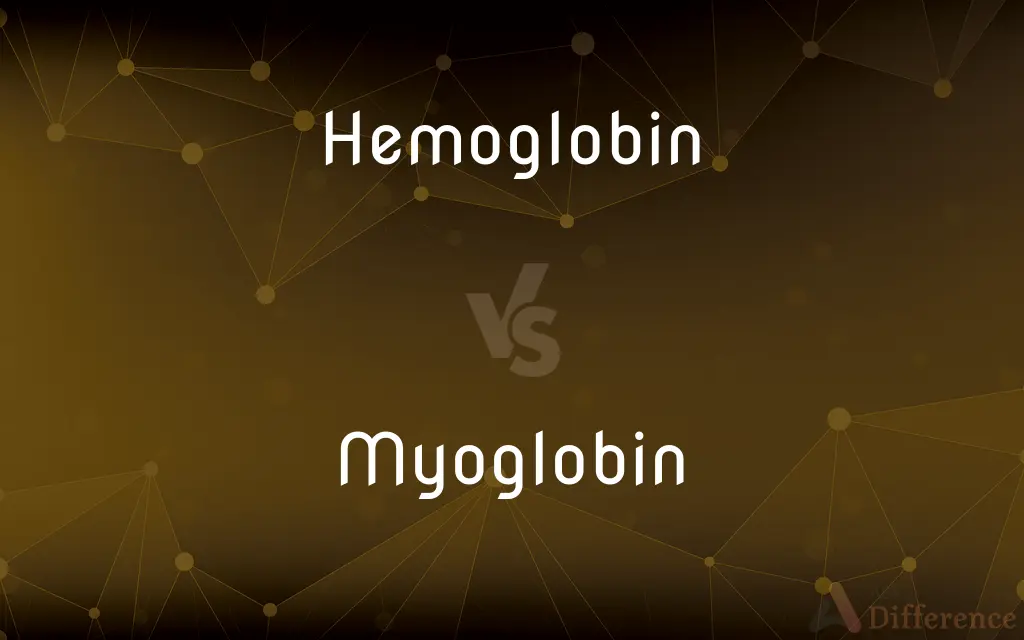Hemoglobin vs. Myoglobin — What's the Difference?
By Tayyaba Rehman & Fiza Rafique — Updated on March 19, 2024
Hemoglobin is a blood protein facilitating oxygen transport in many animals, while myoglobin, found in muscle tissues, stores oxygen for muscle metabolism.

Difference Between Hemoglobin and Myoglobin
Table of Contents
ADVERTISEMENT
Key Differences
Hemoglobin, a complex protein in red blood cells, carries oxygen from the lungs to the body's tissues and returns carbon dioxide from the tissues back to the lungs. It consists of four polypeptide chains and can bind up to four oxygen molecules. Myoglobin, on the other hand, is a single-chain protein found in muscle cells, where it serves as an oxygen reservoir and facilitates the transport of oxygen within muscles. Its high affinity for oxygen allows it to store oxygen for use during muscle contraction, especially important in sustaining muscle activity during intense exercise.
Hemoglobin's structure allows it to undergo conformational changes as it binds and releases oxygen, a property that optimizes oxygen delivery based on tissue needs. Myoglobin, with its simpler structure, does not exhibit such cooperative binding, maintaining a strong affinity for oxygen under a wide range of conditions. This makes myoglobin efficient at oxygen storage but less versatile in oxygen transport.
The function of hemoglobin is closely linked to its role in the circulatory system, making it vital for sustaining the metabolic activities of all body tissues. Myoglobin's function is more localized, primarily supporting oxygen consumption in muscle tissues, which is crucial during periods of high demand, such as during vigorous physical activity.
In terms of oxygen affinity, hemoglobin's affinity varies with the partial pressure of oxygen, allowing it to pick up oxygen in the lungs (where oxygen pressure is high) and release it in the tissues (where oxygen pressure is low). Myoglobin, with its higher oxygen affinity, holds onto oxygen until it is needed by the muscle cells, releasing it only when the muscle's oxygen demand spikes.
Both proteins are essential for aerobic respiration but play distinct roles reflecting their structural differences and the differing oxygen requirements of blood and muscle tissues.
ADVERTISEMENT
Comparison Chart
Structure
Tetramer (4 polypeptide chains)
Monomer (1 polypeptide chain)
Function
Transports oxygen in blood
Stores oxygen in muscle cells
Oxygen Binding Capacity
Binds up to 4 oxygen molecules
Binds 1 oxygen molecule
Oxygen Affinity
Variable, adapted for oxygen release and pickup
High, adapted for oxygen storage
Role in Respiration
Delivers oxygen to all body tissues
Provides oxygen to muscles during high demand
Compare with Definitions
Hemoglobin
A red blood protein responsible for oxygen transport.
Hemoglobin levels are crucial in diagnosing anemia.
Myoglobin
A protein in muscle cells that stores and transports oxygen.
Myoglobin gives muscle tissue a reddish color.
Hemoglobin
Consists of four subunits, allowing it to carry multiple oxygen molecules.
The quaternary structure of hemoglobin is key to its function.
Myoglobin
Contains a single polypeptide chain.
Myoglobin's simpler structure is suited for oxygen storage.
Hemoglobin
Exhibits cooperative oxygen binding.
Hemoglobin's affinity for oxygen increases as it binds more oxygen molecules.
Myoglobin
Has a high affinity for oxygen, even at low partial pressures.
Myoglobin releases oxygen when muscles are under intense activity.
Hemoglobin
Plays a key role in regulating blood pH.
Hemoglobin buffers blood by binding to hydrogen ions.
Myoglobin
Crucial for aerobic metabolism in muscle tissue.
Diving mammals have high levels of myoglobin to sustain prolonged dives.
Hemoglobin
Found in red blood cells.
A high hemoglobin count can indicate polycythemia.
Myoglobin
Acts as an oxygen reserve during muscle contraction.
Myoglobin's oxygen reserve is essential during anaerobic conditions.
Hemoglobin
Hemoglobin, or haemoglobin (spelling differences) (from Greek αἷμα, haîma 'blood' + Latin globus 'ball, sphere' + -in) (), abbreviated Hb or Hgb, is the iron-containing oxygen-transport metalloprotein in the red blood cells (erythrocytes) of almost all vertebrates (the exception being the fish family Channichthyidae) as well as the tissues of some invertebrates. Hemoglobin in blood carries oxygen from the lungs or gills to the rest of the body (i.e.
Myoglobin
Myoglobin (symbol Mb or MB) is an iron- and oxygen-binding protein found in the skeletal muscle tissue of vertebrates in general and in almost all mammals. Myoglobin is distantly related to hemoglobin.
Hemoglobin
The protein in the red blood cells of vertebrates that carries oxygen from the lungs to tissues and that consists of four polypeptide subunits, each of which is bound to an iron-containing heme molecule.
Myoglobin
A single-chain, iron-containing protein found in muscle fibers, structurally similar to a single subunit of hemoglobin and having a higher affinity for oxygen than hemoglobin of the blood.
Hemoglobin
(American spelling) The iron-containing substance in red blood cells that transports oxygen from the lungs to the rest of the body; it consists of a protein (globulin), and haem (a porphyrin ring with an atom of iron at its centre).
Myoglobin
(protein) A small globular protein, containing a heme group, that carries oxygen to muscles.
Hemoglobin
The normal coloring matter of the red blood corpuscles of vertebrate animals. It is composed of hematin and globulin, and is also called hæmatoglobulin. In arterial blood, it is always combined with oxygen, and is then called oxyhemoglobin. It crystallizes under different forms from different animals, and when crystallized, is called hæmatocrystallin. See Blood crystal, under Blood.
Myoglobin
A hemoprotein that receives oxygen from hemoglobin and stores it in the tissues until needed
Hemoglobin
A hemoprotein composed of globin and heme that gives red blood cells their characteristic color; function primarily to transport oxygen from the lungs to the body tissues;
Fish have simpler hemoglobin than mammals
Common Curiosities
How does myoglobin contribute to muscle function?
Myoglobin stores oxygen in muscle cells, providing an essential oxygen supply during intense muscle activity.
Why does hemoglobin have a variable affinity for oxygen?
Hemoglobin's variable oxygen affinity enables efficient oxygen uptake in the lungs and release in tissues where it's needed.
What makes myoglobin's oxygen affinity higher than hemoglobin's?
Myoglobin's high oxygen affinity ensures that it can store oxygen effectively, even at low oxygen concentrations.
How do hemoglobin and myoglobin's structures reflect their functions?
Hemoglobin's tetrameric structure allows it to transport multiple oxygen molecules, while myoglobin's simpler structure is optimized for oxygen storage.
Can hemoglobin and myoglobin be affected by diseases?
Yes, various conditions can impact their levels and function, such as anemia (affecting hemoglobin) and muscle disorders (influencing myoglobin).
How do environmental factors affect hemoglobin and myoglobin?
Factors like altitude can influence hemoglobin levels, while myoglobin levels may adapt to changes in physical activity patterns.
What is the primary function of hemoglobin?
Hemoglobin transports oxygen from the lungs to tissues and assists in carrying carbon dioxide back to the lungs.
What happens to myoglobin during muscle activity?
Myoglobin releases its stored oxygen during high muscle activity to meet the increased oxygen demand.
Are there dietary sources that can affect hemoglobin and myoglobin levels?
Iron-rich foods are essential for both proteins' synthesis, as iron is a key component of their oxygen-binding sites.
Can hemoglobin and myoglobin levels be measured?
Yes, blood tests can measure hemoglobin levels, while myoglobin levels can be assessed in both blood and urine, particularly after muscle injury.
Share Your Discovery

Previous Comparison
Protocoled vs. Protocolled
Next Comparison
Christianity vs. CatholicismAuthor Spotlight
Written by
Tayyaba RehmanTayyaba Rehman is a distinguished writer, currently serving as a primary contributor to askdifference.com. As a researcher in semantics and etymology, Tayyaba's passion for the complexity of languages and their distinctions has found a perfect home on the platform. Tayyaba delves into the intricacies of language, distinguishing between commonly confused words and phrases, thereby providing clarity for readers worldwide.
Co-written by
Fiza RafiqueFiza Rafique is a skilled content writer at AskDifference.com, where she meticulously refines and enhances written pieces. Drawing from her vast editorial expertise, Fiza ensures clarity, accuracy, and precision in every article. Passionate about language, she continually seeks to elevate the quality of content for readers worldwide.














































